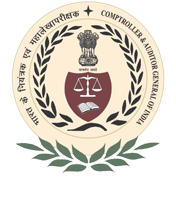Audit Reports

Jharkhand
Report No. 5 of 2016 - State Finances, Government of Jharkhand for the year ended 31 march 2016
Overview
Based on the audited accounts of the Government of Jharkhand for the year ended 31 March 2016, this Report provides an analytical review of the Annual Accounts of the State Government.
Chapter: 1 Finances of the State Government
· The Gross State Domestic Product (GSDP) of Jharkhand State grew at the rate of 11.4 per cent during 2015-16 against the Fourteenth Finance Commission (14thFC) projection of 11.73 per cent for the year.
· The State had a Revenue Surplus of `4,085 crore during 2015-16, whereas,Fiscal Deficit increased to `11,523 crore due to receipt of `5,553 crore on UDAY Bonds. It was 4.8 per cent of GSDP, much beyond the recommended ceiling (3.5 per cent) by the 14thFC.
· During 2015-16, the Revenue Receipts grew at 28.7 per cent over the previous year. However, in comparison to the budget estimate, the Revenue Receipts were less by
` 7,389 crore during the year.Out of total Revenue Receipts, 57 per cent came from Central Tax Transfer and GOI grants, while State’s Own Resources contributed the balance.
· Capital Expenditure (CE) increased to ` 8,159 croreduring 2015-16 which was16 per cent of Total Expenditure. The percentage of CE to GSDP was 3.4 per cent during
2015-16.
· Financial assistance by the State to Local Bodies and other institutions increased from
` 12,404.02crore in 2014-15 to `14,890.92 crore during 2015-16.
· During 2015-16, Fiscal Liabilities of the State (` 56,530 crore) grew by 29.7 per cent mainly due increase in Internal Debt by 34 per cent. The Fiscal Liabilities were 23.4 per cent of GSDP.
· The incremental non-debt receipts (resources gap) increased from
(-) ` 2,885 crore in 2014-15 to ` 4,313 crore in 2015-16 which was indicative of improvement in fiscal position of the State.The ratio of Interest Payments to Revenue Receipts stood at 8.17 per cent in 2015-16.
Chapter: 2Financial Management and Budgetary control
· There were large savings of ` 17,524.86 crore during 2015-16 indicating improper budget estimation. Large savings under various schemes/sub-heads may adversely affect the implementation of development programmes in the State. Persistent savings for not less than of 10 per cent or more of the grant were also noticed in 11 departments performing Social Services and Economic Services during the last five years.
· Excess expenditure of ` 2,739.12 crore over provisions occurred during 2001-15. This requires regularisation under Article 205 of the Constitution of India.
· The Urban Development and Housing Department was not following the provisions of the Budget Manual leading to lack of budgetary control in the Department. This resulted in large savings of ` 889.21 crore, rush of expenditure of ` 789.61 crore in 40 sub-heads at the fag end of the financial year. Accounts of ` 1,575.29 crore were also not reconciled with the books of the Principal Accountant General (A&E).
Chapter: 3 Financial Reporting
· Utilisation certificates (UCs) of `22,325.68 crore against the Grants-in-Aid bills drawn upto 2014-15 by different departments were outstanding as on 31 March 2016. This was indicative of failure of the departmental officers to comply with the rules and procedures to ensure timely utilisation of the grants for the intended purpose.
· The total amount for which DC bills were received was `11,610 crore against the total value of AC bills of ` 17,081 crore drawn during 2000-16. This leads to an outstanding balance of DC bills worth `5,471 crore as on 16 May 2016.
· There was a huge balance of ` 5,217.97 crore in Personal Ledger Accounts at the end of March 2016. The drawal of government money to prevent it from being lapsed and keeping it in PL Accounts for its expenditure in the years other than in which it was approved by the Legislature not only violated the Financial Rules but also led to the failure of budgetary control by the State.
Download Audit Report
-
Index of Report No.5 of 2016 - State Finances Government of Jharkhand
 (0.09 MB)
Download
(0.09 MB)
Download
-
Preface of Report No.5 of 2016 - State Finances Government of Jharkhand
 (0.02 MB)
Download
(0.02 MB)
Download
-
Executive Summary of Report No.5 of 2016 - State Finances Government of Jharkhand
 (0.06 MB)
Download
(0.06 MB)
Download
-
Chapter 1 Finances Of The State Government of Report No.5 of 2016 - State Finances Government of Jharkhand
 (1.02 MB)
Download
(1.02 MB)
Download
-
Chapter 2 Financial Management And Budgetary Control of Report No.5 of 2016 - State Finances Government of Jharkhand
 (0.17 MB)
Download
(0.17 MB)
Download
-
Chapter 3 Financial Reporting of Report No.5 of 2016 - State Finances Government of Jharkhand
 (0.20 MB)
Download
(0.20 MB)
Download
-
Appendix of Report No.5 of 2016 - State Finances Government of Jharkhand
 (0.75 MB)
Download
(0.75 MB)
Download

